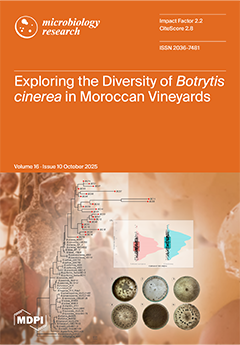Diaphorobacter nitroreducens is a Gram-negative bacterium ubiquitously found in wastewater, recognized for its ecological adaptability and potential applications in environmental, biomedical, and industrial processes. Central to its adaptability is the
nfrB gene, which encodes a cyclic di-3′,5′-guanylate (c-di-GMP)-activated glycosyltransferase. This enzyme facilitates the
[...] Read more.
Diaphorobacter nitroreducens is a Gram-negative bacterium ubiquitously found in wastewater, recognized for its ecological adaptability and potential applications in environmental, biomedical, and industrial processes. Central to its adaptability is the
nfrB gene, which encodes a cyclic di-3′,5′-guanylate (c-di-GMP)-activated glycosyltransferase. This enzyme facilitates the secretion of biofilm-associated extracellular polymeric substances (EPS), essential for its survival and functionality in diverse environments. Using complete EMJH media as a selective medium,
D. nitroreducens was successfully isolated from soil and water samples from Estero de Paco, Manila, Philippines, enabling downstream analyses of its
nfrB gene. Phylogenetic analyses revealed that the
nfrB gene tree deviates significantly from the canonical 16S rRNA gene tree, with
D. nitroreducens clustering alongside members of the
Enterobacteriaceae family. This deviation suggests the potential influence of horizontal gene transfer, adaptive evolution, or lineage-specific pressures on
nfrB evolution. Structural analysis of NfrB through Alphafold 3 prediction demonstrated a conserved N-terminal region across taxa, except for the outgroup
Zymomonas mobilis. Conversely, the C-terminal region, housing the catalytic domain, showed considerable diversity, reflecting adaptive modifications across bacterial lineages. Despite this variability, the putative binding site for cyclic di-3′,5′-guanylate remained conserved, indicating a balance between functional conservation and adaptive diversification. These findings not only deepen the existing understanding of bacterial signaling and glycosylation mechanisms but also provide insights into the evolutionary dynamics of glycosyltransferases. Furthermore, the study underscores the potential of NfrB as a target for innovative applications, including the design of novel biocatalysts and the development of informed strategies for bacterial management in environmental, industrial, and biotechnological contexts.
Full article





